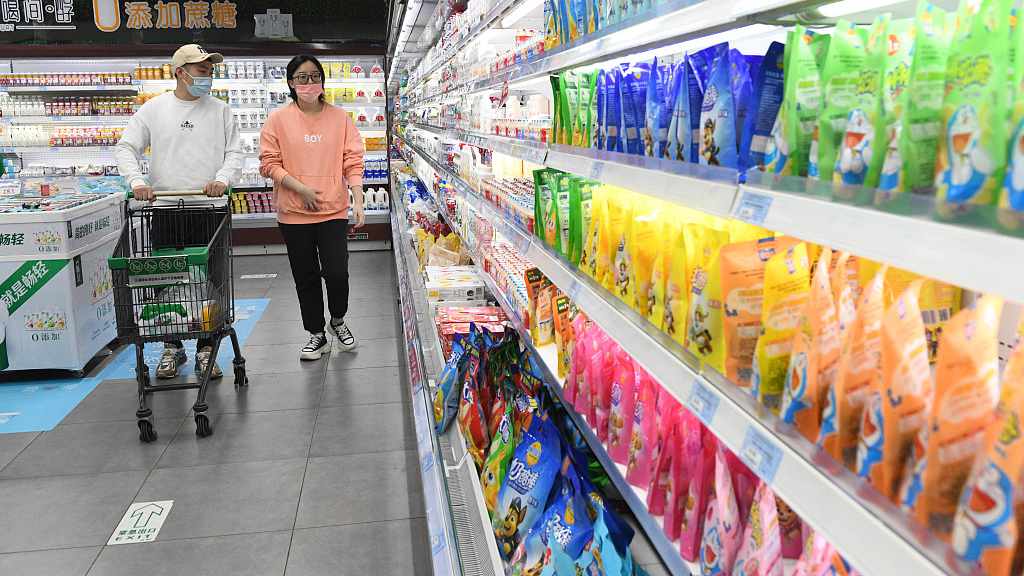
Dairy products in a supermarket in Xinle City, Shijiazhuang, north China's Hebei Province, May 11, 2022. /VCG
Dairy products in a supermarket in Xinle City, Shijiazhuang, north China's Hebei Province, May 11, 2022. /VCG
Editor's note: Chen Jiahe is the chief investment officer at Novem Arcae Technologies. The article reflects the author's opinions, and not necessarily the views of CGTN.
This morning, the National Bureau of Statistics of China published the latest data for the Chinese economy. Overall, China's inflationary environment is within a very moderate range. At a time when inflation is becoming a headache for the global economy, this low inflationary environment is especially valuable. Let's take a detailed look at today's data and find out the future trend of China's inflation.
In April 2022, the Consumer Price Index (CPI) of China increased by 2.1 percent on an annual basis. In the past six months, this CPI figure has fluctuated between 2.3 percent and 0.9 percent. The latest figure shows that the CPI remains at a very moderate level.
However, if we compare this 2.1 percent growth rate with the data in February and March, which were 0.9 percent and 1.5 percent, respectively, the CPI in April is still slightly higher. There are two reasons behind this slight increase: the rising food price and the energy price.
In the composition of China's CPI, the food price is the most important component as China is still a developing country, and food consumption still accounts for the largest part of the consumption of China's citizens. The percentage of food consumption can be lower in metropolises like Beijing and Shanghai, where the per capita GDP is around $30,000. But in many provinces with lower per capita GDP, food consumption is still the largest expense for many families.

A supermarket in Xinle City, Shijiazhuang, Hebei Province, China, May 11, 2022. /VCG
A supermarket in Xinle City, Shijiazhuang, Hebei Province, China, May 11, 2022. /VCG
According to the latest data, the CPI for food consumption increased by 1.9 percent in April. Vegetable prices, which increased by 24 percent compared to a year ago, are the biggest contributor to the overall price of food. The main reason behind this price hike are the measures to control COVID-19. However, with the gradual opening of Shanghai and the decreasing COVID-19 cases, the consequences of these control measures are fading.
In contrast to the price of vegetables, the price of pork fell by 33.3 percent, as the pork shortage caused by the swine flu in 2021 is no longer an issue. The massive supply of pork in China's market is now bringing down the price, as well as the stock prices of relevant pork production companies. The large drop in pork prices has offset much of the hike in vegetable prices.
The CPI of non-food components increased by 2.2 percent in April, which means they have made a similar contribution to the CPI when compared with food prices.
Within the non-food components, the transport and communication sector made the largest contribution to the price rise. Data showed the price of transport and communication in China increased by 6.5 percent in April compared with one year ago.
However, looking into the details of the sector, we can find that the price rise has nothing to do with communication.
In April, the communication price dropped by 3.1 percent, which means Chinese people are now spending less and less for their phone calls and internet data flows. It is the price of transport, especially the price of transportation fuel, that has made the biggest contribution. In April, the price of transportation fuel increased by 28.4 percent. As China now imports around 70 percent of its crude oil, the soaring global oil price is clearly the reason behind this price rising.
Besides food and fuel prices, the prices of other items in China's CPI are stable.
For example, the CPI of clothing increased by merely 0.5 percent in April, and the price for medical services increased by 0.7 percent. The small increase for medical services also shows that China's anti-COVID-19 policy has achieved a remarkable result. The requirement for medical services remained low because very few people were infected. The price for housing has also increased by a moderate level of just 1.2 percent.
Overall, the CPI growth in April is mainly attributed to the rise in food prices and fuel prices. The National Statistics Bureau has also published the CPI without food and fuel, which has grown by merely 0.9 percent on an annual basis.
Looking into the future, we can be confident that food prices will soon come down since the blockades in Shanghai and some other cities are coming to an end. China is now conducting a massive amount of nucleic acid tests (NATs), which have been found to be an effective way of detecting potential COVID-19 carriers. With the frequent employment of NATs, it is believed that blockades can happen less often in the future.
Meanwhile, fuel prices face a lot of uncertainty. Will the Ukraine crisis come to an end? Will OPEC reduce its production to boost prices? Will America increase its oil exports? There are too many factors that can affect the oil price. However, one thing we know for sure is that since the global average production cost for oil is now around $60 per barrel, high oil prices are unsustainable in the long term: more production will be encouraged and increased production itself can bring a negative impact to oil prices in the long-term.
(If you want to contribute and have specific expertise, please contact us at opinions@cgtn.com. Follow @thouse_opinions on Twitter to discover the latest commentaries in the CGTN Opinion section.)

